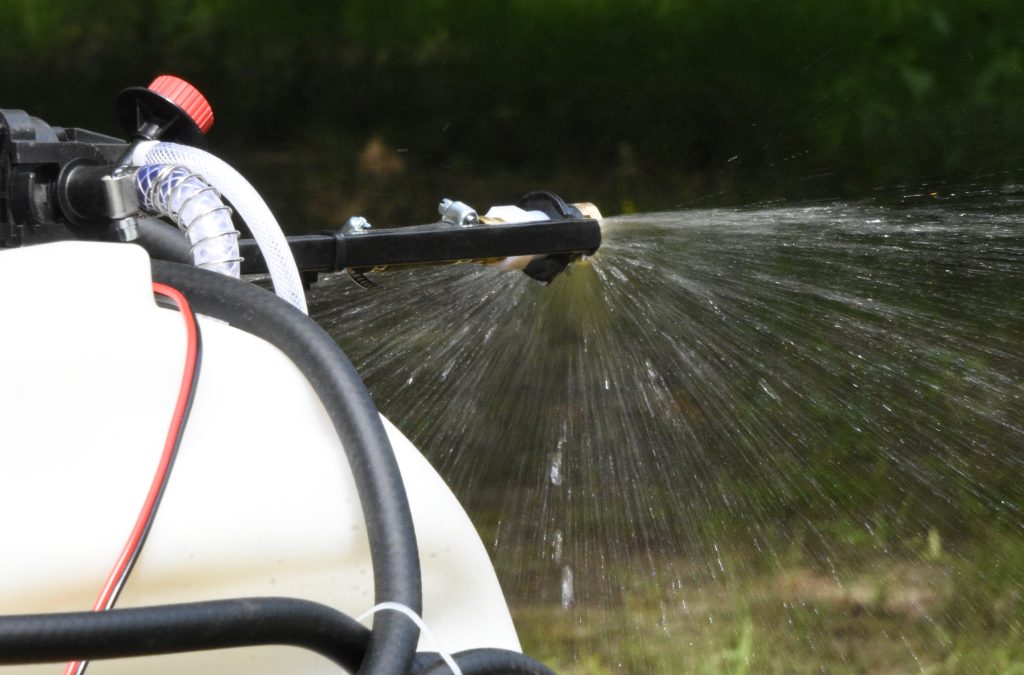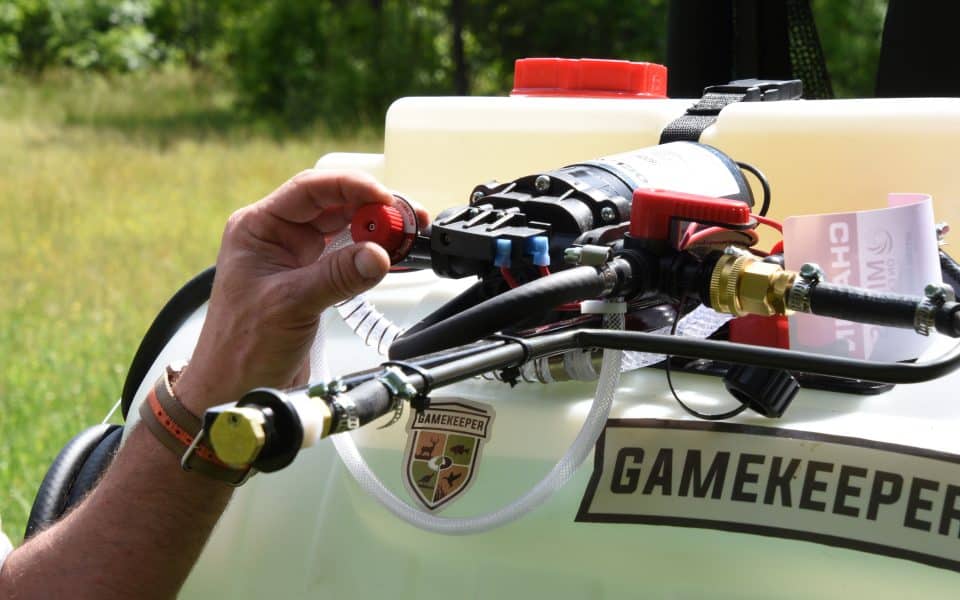Before you can accurately apply the right amount of herbicide or liquid fertilizer to a plot, you have to know how much spray mix is being put out per acre. Knowing this will help you determine how much herbicide to add and how many acres you can cover with one tank, thus how much herbicide to add to each tank. To calibrate a sprayer isn’t difficult, but it can be challenging if you have never done it before.
Do y’all like math? Calibrating a sprayer will require some, but we’ll try to make it easy. In years past I’ve done the “educated hillbilly method” — basically figuring out the output over a given portion of an acre and then dividing that into an acre. This would give you the number to multiply your liquid amount by and give you your solution of how much to apply per acre. This was time consuming, but I was good at math in school so it served me well. However, there are much easier methods!
Helpful Conversions
- 1 acre = 43,560 feet²
- 1 gallon = 128 fluid ounces = 8 pints = 4 quarts
Much will depend upon the type and number of sprayer nozzle(s) you have. With ATV mounted sprayers, I’ve used both a boom sprayer with four to eight nozzles, and a bloomless nozzle. Larger tractor mounted sprayers may have 20 nozzles or more. It should go without saying, but you want to use plain water when doing these calibrations. The goal is to figure out how much liquid your sprayer puts out over a given area — so you will need a laser range finder or a 100 to 200-foot open-reel tape measure to measure distance. You will also need some sort of a stopwatch or way to precisely assess the amount of time it takes you to cover the given distance. You’ll also want some flags or some way to mark the start and end of your course. Finally, you’ll need a way to measure liquid — something a little larger than a one-cup kitchen measuring cup is recommended, but even that can work in a pinch.
Boom Sprayer Calibration

There are numerous ways to calibrate a sprayer, but the simplest method I’ve seen is the “1/128-acre method,” also referred to as the “baby bottle method.” I believe I first stole this method from the Alabama A&M Extension. This technique scales down the calibration course to 1/128 acre (340 feet²). Why? Because there are 128 fluid ounces in a gallon. This means that the spray collected from a single nozzle (in fluid ounces) directly compares to gallons per acre (GPA) regardless of the number of nozzles on the boom. This is so much easier than the way I used to do it — having to collect the liquid from all the nozzles and lots of head-scratching math.
First, fill the sprayer with clean water. Measure your nozzle spacing in inches, and then convert it to feet by dividing by 12. Refer to the following chart to determine your calibration course length. Measure and mark the appropriate calibration course length based on your nozzle spacing. The course should be on the same type of ground that you will be spraying so your speed is the same. Drive the course in the same gear, speed and RPM you would use when actually spraying and record this time in seconds. Do it three times and use the average. Then, park the tractor or ATV and maintain the same RPM (if it is a sprayer that requires the RPMs to maintain the sprayer’s pressure). Turn on the sprayer, and catch the water from one nozzle for exactly the same time that it took to drive the calibration course. The ounces caught should equal gallons per acre.
To determine the calibration course length for a nozzle spacing not listed, first convert the distance between two nozzles from inches to feet. Then divide 340 by the nozzle spacing in feet (as said, 1/128 of an acre is 340’). For example: Calibration distance for 19” nozzle spacing would be 340 divided by 19, then times 12 = 215 feet.

Multiply how many acres you are able to do per tank by how much herbicide needed per acre. Then you’ll know how much herbicide to put in each tankful.
Boomless Sprayer Calibration

As with the calculations above for the boom sprayer, we will scale this down to a fraction of an acre. In this case, 1/8 of an acre (5,445 feet²) as output will be measured in pints. Just like above calculations, we’re converting the area covered into numbers that are easily used with liquid measurements. The sprayer output collected from the boomless nozzle measured in pints will also directly correlate to gallons per acre.
Fill the sprayer with clean water. Turn the sprayer on and measure the effective swath width in feet. Spray patterns are most visible on concrete, asphalt or dry soil. Refer to the following chart to determine your calibration course length. Drive the course in the speed, gear, and RPM you will use when actually spraying. Record the time in seconds. Do this three times and take the average. Then park your tractor or ATV and maintain the same RPM (again, if it is a sprayer that requires the RPMs to maintain the sprayer’s pressure). Turn on the sprayer, and use a trash bag, or other clean receptacle to catch the water for exactly the same number of seconds required to drive the calibration course. Pints caught = gallons per acre.
To determine the length of your calibration course for a swath width not listed, divide 5,445 feet² (1/8 acre) by the swath width in feet. For example: Calibration distance for 26’ swath width = 5,445 divided by 26 = 209 feet. For a 9’ swath it would be 5,445 divided by 9 = 605 feet, or 201.7 yards.

Want to learn more about spraying food plots? Listen to episode 96 of the Gamekeeper Podcast.






